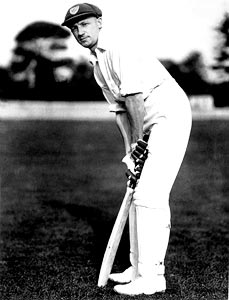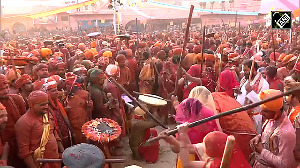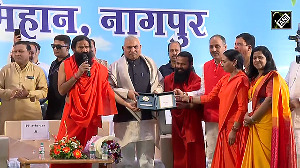Haresh Pandya pays tribute to the legendary Sir Don Bradman on the occasion of his 104th birth anniversary
Cricketers of different hues come and go but the legend of Donald George Bradman lives on. Like Julius Caesar, he remains as powerful in death as he was during and after his eventful playing days. His 104th birth anniversary is being celebrated today (August 27).
So much has been said, more written, on Bradman's majestic batsmanship and staggering statistics that it is pointless to dwell on them here and bore the cricket lovers, who ought to know something about the man and his sunshine cricket. But, like some other sporting greats, there are plenty of other things regarding Bradman and his game which not too many probably know.
Like Pele, Dhyan Chand, John McEnroe and others of their ilk, Bradman was a phenomenal ball player, albeit in a different way. So complete was his mastery over the ball that you felt as if it were Bradman, rather than bowlers, who made the cherry do his bidding! He had all the time in the world to play his shots and, unsurprisingly, had at least two different strokes for every delivery.
 This rare trait in Bradman's batting could be attributed to his being very good at tennis and golf before he began to take up cricket seriously. He excelled in tennis in his hometown Bowral when in his early teens. His uncle owned a tennis court and the young Don made the most of it. So much that he did not pick a cricket bat for one whole summer.
This rare trait in Bradman's batting could be attributed to his being very good at tennis and golf before he began to take up cricket seriously. He excelled in tennis in his hometown Bowral when in his early teens. His uncle owned a tennis court and the young Don made the most of it. So much that he did not pick a cricket bat for one whole summer.
Golf came just about as easily to him as the love-all game. In fact, Bradman taught himself the skills of cricket by hitting a golf ball. He would middle everything, just like when he wielded the willow, a satisfying, clean ping to each shot. But the willow game being his first love, he had to choose among cricket, tennis and golf before it was too late. Of course, the loss of tennis and golf was cricket's massive gain.
But he could never distance himself from tennis and golf. He could play the two sports hours on end whenever he had time at his disposal. They helped him relax nicely and gave him a bit of a change. Even in his old age he was a regular visitor to The Royal Adelaide Golf Club. It was not uncommon to see him in baggy grey flannels, chipping and driving. It was quite a sight to see his iron-play long and short, to see him putt -- the forward defensive.
Strangely, minutes after Bradman scored 452 not out in a first-class game down under, Cassandras had the temerity to prognosticate disaster for him on the English pitches. But the shrewd Learie Constantine had the wisdom to understand his batting. "It's true many of his scoring shots are so unorthodox that he should be unfrocked. But where is the bowler who can unfrock him?" said the West Indian.
How Bradman mesmerised the English in 1930 is history. As he was making his first Test hundred in England, a Nottinghamshire fan in the stands pleaded with Maurice Layland in this manner: "Bowl him Maurice, bowl him middle-stump!" Similarly, when Bradman approached 250 in his next Test century, crowds were volubly expressing amazement and dismay. But a cockney retorted: "Blimey! What are you worrying about? It's only a quarter of a thousand!"
When he was finally dismissed after scoring a world-record 334 at Leeds, an English newspaper ran a headline: "He's Out!" After he scored 974 in the five-Test series, a gentleman, good-humoured and enthusiastic, proposed a fund for his "assassination" in order to save the bowlers from the always impending mayhem the Aussie was so clever at creating.
Contrary to the popular perception and all the negative things said about Douglas Jardine, the English captain had actually paid Bradman the ultimate tribute by inventing the now infamous Bodyline attack to check his flow of runs. Jardine and his trump card Harold Larwood managed to bring down Bradman's average to a mortal but still monumental 56.57 runs per innings in the most controversial of all Test series!
Few sporting icons could approach Bradman in terms of mind-boggling popularity. It was often very disconcerting for the batsmen who followed him at the wicket. Whenever he was dismissed, a large section of the crowd would file out of the ground. He was not less popular off the field. Despite being an Australian, he was a god-like figure in England in the 1930s.
Bradman's tours across England in the decade he ruthlessly dominated were like those of a Hindu spiritual guru commanding a large following. The English literally made a pilgrimage to have a glimpse of Bradman on or off the field.
Doubtless he had become an object of hero-worship, not just in Australia and England, amounting to idolatry. After his memorable tour of England in 1930, he had to be brought back to Sydney ahead of the rest of his Australian team-mates for obvious reasons. Not only that, he had to be chauffeured back to Bowral.
Bradman's understandable preference for his privacy was often mistaken for arrogance. But the fact could not be denied that for all his success and fame, for all his hardcore professionalism as a player, and for all his acumen and pragmatism as a businessman, Bradman was a nice human being, too. Some of his noble acts are not well-known.
When Bradman was young and not so renowned, he was once addressed simply as "Don" by an elderly dressing room attendant at Sydney Cricket Ground (SCG). When he became a celebrity, the old man at the SCG thought it meet to tell him "Mr. Bradman". But the cricketer was too polite a man to get carried away by the stardom. "No, Uncle John, it's still Don to you," said Bradman.
Many years later, after being knighted, Bradman visited the SCG dressing room and met the same man, who then addressed him as "Sir Donald". But again Bradman told him: "Dear Uncle John, I'm still plain Don to you, as always."
In England in 1934, Bradman was once strolling along the Thames embankment. He saw a number of people in rags and visibly half-starved. So moved was he on seeing their miseries that he ordered a cup of coffee and a snack for each one of them from a nearby cafe. When some of them asked him to reveal his identity, he only smiled his broad, toothy smile and gave a sovereign to them all, feeling sure that their poverty might have prevented them from being interested in sports, let alone identifying famous players.
Though not devastatingly handsome, he was capable enough of attracting even those women who knew nothing of the game. Many of them felt Bradman had tremendous sex appeal. Even in England, women would flock to see him; fight to get near him, to kiss him or just to touch his shoulder or his sleeve.
However, he always remained faithful to his childhood sweetheart, Jessie Menzies, whom he married in 1932. They enjoyed a very happy married life of 65 years. "My wife and I are humbly proud of each other; and also of our long and successful married life," he told me in a personal letter in the early 1990s.
But the happy couple had to bear many a personal tragedy. Their first child, a boy born in 1936, died in less than 24 hours of his birth. Polio struck John Russell Bradman, another son born in 1939, when he was 12. But he was lucky enough to recover completely after some time. Their daughter Shirley Jane, born in 1941, suffered from cerebral palsy.
When Jessie Menzies died of cancer in September 1997, the Don was a "broken" man. Her passing away attracted international headlines. Obituary notices were published in the leading newspapers of the cricket world because she was, after all, Don Bradman's better half.
And when the Don himself breathed his last on February 25, 2001, even The New York Times, among a number of prominent newspapers in the non-cricketing world, had paid him an 827-word tribute with a befitting headline: "Sir Donald Bradman, 92, Cricket Legend, Dies".
Photograph: Keystone/Getty Images












 © 2025
© 2025